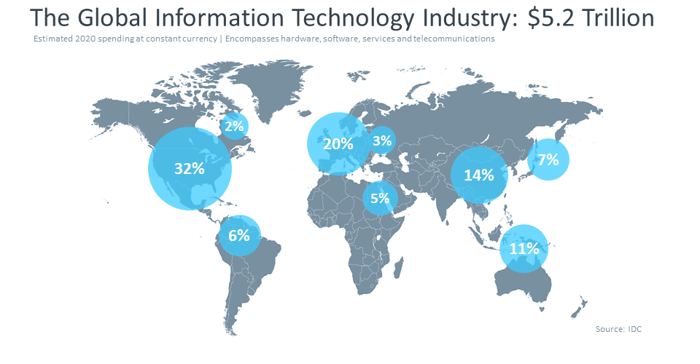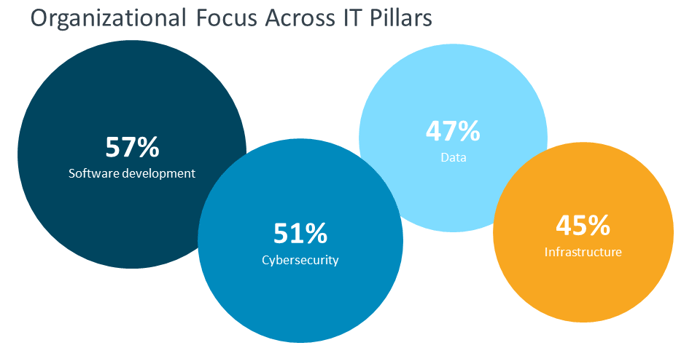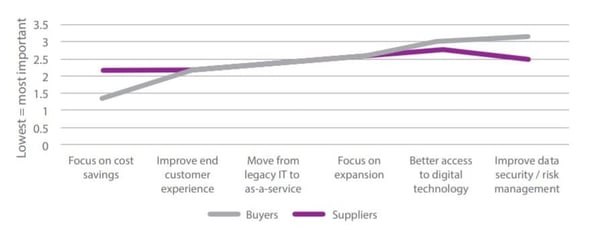Technological advancements and organizational IT needs are constantly evolving by shaping business structures. The market is currently in a transition phase in terms of the type of business operations that are most commonly outsourced.
To scale your business in the new digital world you need to drive innovation into every product and service that you create. According to the research consultancy IDC, the global information technology industry is on pace to reach $5.2 trillion in 2020.

As organisations mature in the way they use technology, there is massive engineering demand across at least four major IT pillars. Software development is the area where most companies expect to place focus in the upcoming year, but there is also strong demand for data, cybersecurity, and infrastructure (DevSecOps).

Source: Comptia
When it comes to software outsourcing, focusing on operational efficiency is necessary for growing businesses and this means bringing products to the market faster.
According to a 2019 Statista report, we are going to witness a steep growth in global IT outsourcing spending. If in 2018 the turnover in the IT-outsourcing market was projected to be 378.1 billion U.S. dollars, by 2021, the IT-outsourcing market is expected to amount to approximately 413.7 billion U.S. dollars.
What do we know about software outsourcing today?
Software outsourcing is a process. It is a solid strategy of handing the responsibility of software development to an individual, a team, or an external company, to get expertise, maximize efficiency, optimize costs, and improve core services.
Based on proximity – and time-zone – there are three basic types of software development outsourcing that are used by businesses around the world: onshore, nearshore, and offshore.
- Onshoring: the process of hiring a third party vendor within your country or your region. The great advantage is that there are no time-zone or cultural differences, and you can easily meet in person to discuss the details of your cooperation; however, in terms of cost, depending on where you are, the benefits may be limited.
- Nearshoring: involves partnering with a development team in a country on the same continent and which is easily accessible in terms of location and cost. It ticks the boxes in terms of competitive cost, cultural similarity, almost-identical time zone, language, ease of travel, and currency stability. This can bring significant cost-benefit value.
- Offshoring: the development team is located on another continent. Despite the time zone difference and long travel times, the access to a specialized talent pool, the maturity of software delivery, business ethics, and the significantly lower cost for professional engineering services, makes offshoring an appealing option.
Our advice?
“Go to where the experts are, as long as you can overlap by at least 2-3 working hours.
Use teams, not freelancers, for a consolidated way of working and ease of management. Use credible companies, with a proven track record. You will need to communicate frequently and efficiently. How well do they speak your business language?
Cost is important, but should not be the ultimate influencing factor. It should be Value. Choose a right-size partner. A company operating in an apartment may be a good outsourcing partner for an early-stage start-up, but it will be challenging to scale as the business evolves. Similarly, a very large, multinational enterprise (vendor) may not accommodate the “cultural fit” that your business is eager to keep as you step into an international outsourcing relationship” says Sorin Gavanescu, Encora Engineering Managing Partner.
IT outsourcing trends
At the end of 2019, there were around 24 million developers worldwide and it is predicted that the global developer population will need to increase to around 29 million by 2024 according to Statista.
In the USA, there are almost 500,000 software developer open jobs on the market and it’s estimated that another 500.000 software developers will retire in the next few years. The expectation is that by 2021, there will be a shortage of 1.4 million software developers in the US alone, while the employment of software developers is projected to grow 21 percent from 2018 to 2028, according to Ncube.
In 2019, Germany was short of 82,000 IT staff, almost 50 percent more than the previous year.
“At the moment, nobody expects demand and supply on the German market for IT specialists to converge in the near future. And so those companies are at an advantage that has already made a name for themselves as attractive employers in foreign markets. Some start-up companies have outsourced the development process for their software to subsidiaries in Romania. This could also be a viable option for industrial groups.” wrote the German Handelsblatt Today publication.
Software engineering was one of the most sought-after skills before the pandemic and continues to top the job board demand. Most companies address this specialized labour force shortage by outsourcing work to a nearshore or offshore partner that they learn to trust.
But labour shortage is only one of the reasons for companies to outsource and this is the case with mostly IT companies. Non-IT firms, such as banks, manufacturers, telecoms, pharmaceutical companies, news & media groups, healthcare services providers, energy and utility companies, and many other industry players that seek to outsource software engineering roles, are looking for expertise, digital guidance, technical consultancy, and software craftsmanship that they have a hard time sourcing internally.
Understandably, not everyone outsources, nor everyone should.
Despite the many advantages of outsourcing, one of the biggest perceived risks – beyond the protection of intellectual property (IP) – is team management. When the complete team doesn’t sit under the same roof all the time, on the same time-zone, companies fear that the toll on productivity and team collaboration would counter-balance the cost-saving benefits that come with outsourcing.
Nowadays, however, in the context of the coronavirus pandemic that has taken the world by storm, companies start to realize that having the entire team in the office will happen very rarely in the future. Many employees now prefer to work from home, accelerating a trend that was already underway before the coronavirus. Companies need to adapt to the new reality.
IT executives turn – once again – to the outsourcing industry, for creative solutions and quick turnaround. Having worked in diverse environments, domains, and geographies, outsourcers can offer the best medium-to-long-term solutions, especially when providing flexible, outcome-based, commercial models for their managed services.
Outsourcers have been working remotely to their stakeholders for decades, documenting their activity, exchanging performance reports regularly, collecting and providing feedback, measuring the outcome that they bring to the business, and looking for optimal ways of delivering value. What the rest of the world has had to discover and embrace in a few months during the pandemic, outsourcers have already perfected in over 20 years of practice, building processes, tools, and an entire culture of working remotely, planning and executing efficiently, communicating frequently and transparently to stakeholders.
COVID-19 has been an equalizing point for distributed teamwork, turning even in-house squads of employees into virtual teams that collaborate over Slack, Teams, Zoom, Webex, Hangouts, or Skype, instead of being present together in physical meeting rooms at the office. For those who have not experienced this at-scale before, outsourcers can help guide this cultural shift, with minimal business disruption.
Why companies choose software outsourcing as a growth driver
As the demand for technology talent increases, so does the race to get the best software developers around the world. Organisations find themselves in need of good talent that is not always available internally, so they hire professional firms to develop their software or augment their existing teams. Various IT services are sourced from an external vendor for many reasons, from operational flexibility and faster time-to-market through digital skill enhancement, to cost-saving.
As the extent of this transformation is only set to increase over the next few years, the UK National Outsourcing Association (NOA), chose to launch Outsourcing in 2020, a research campaign with 134 surveyed UK organisations, that aims to discover how outsourcing will change as a practice over the next years.
Among the main findings, NOA claims that 70% of buyers plan to increase their use of outsourcing, with 35% planning to do so to a significant extent. None of the organisations surveyed plan to decrease the amount they outsource by a significant measure.
What business cases are increasing the use of outsourcing?

Source: NOA
Overall, 35 percent of respondents chose “cost savings” as the number one reason to outsource. 23 percent chose to “improving customer experience”, followed by the 17 percent who chose “moving towards an as-a-service model”.
Although cost-saving remains at the top of UK business preferences as the most important outsourcing driver, more and more organisations are primarily looking for access to specialized talent and digital expertise. As a result, IT outsourcing relationships are quickly evolving into strategic, long-term partnerships.
According to the 2019/2020 European IT Sourcing Study by Whitelane Research, over the next two years, outsourcing is predicted to grow quite significantly in Europe. The study investigates more than 5000 unique IT sourcing relationships held by over 1600 of the top IT spending organisations in Europe.
Key findings from the 2019/2020 European Study include:
74% of organisations plan to outsource at the same rate or more. Most outsourcing is expected to take place in the financial services sector with 43% citing they are planning to outsource more, followed by the public sector with 39% (up 13% from last year).
58% of organisations are already using Agile as their preferred delivery model with another 28% planning to use it in the near future. The use of Agile is highest in the financial services sector with 66%, while the manufacturing sector is currently lagging but shows the largest percentage of organisations (34%) that are planning to implement the Agile way of working.
When do companies outsource?
If you have a hard time addressing one of the following situations for your company, there is a good chance that a reliable outsourcer can help.
| 1. Where a flexible resource solution is needed
Project demand can’t always be consistent and predictable. Being able to easily flex up and down from a core team is the ideal solution. |
4. To free up internal teams for strategic initiatives and gain speed
Your teams can add more value to your business by applying their IP to strategic projects whilst a Partner can address day-to-day needs. |
| 2. For balance across your Engineering options
Introducing a Nearshore provider such as Encora into your Supplier mix will give you balance to address the different types of projects |
5. To gain quality through specialized skills
A Partner’s teams usually work across multiple industries and technologies, meaning you can access these and benefit from them in a short space of time. |
| 3. To expand, but not replace, internal teams
Your internal teams have vital business knowledge but can be restricted in terms of headcount. Adding a Partner’s team, who can easily integrate into your team, is an ideal solution. |
6. To reduce R&D costs
Nearshore/offshore delivery teams are geared towards structured Agile delivery and can bring the benefit of agile practices to you immediately. |
How can Encora help you on your journey?
Whether your company is still in the startup stage or already a sizable enterprise with global operations, digital innovation must be part of your strategy. To help you achieve it, Encora can be your trusted solution engineering partner.
The most important asset: our people
From initial workshops, competency validation, and contract review, through digital ideation and technology consulting, and following the Agile “build” journey, we can help you launch innovative solutions. Our approach is powered by engineering teams who think, talk and act innovatively and responsibly.
Outsourcing is no longer only a cost-reduction tool, but a means to find the right, culture-add partner, often in a different geography, who can understand your business strategy and flexibly adapt business models and sourcing models to confidently deliver your vision.
At Encora we’ve developed our framework of best practices when working in distributed teams, so customers can communicate with us openly, share with us their digital strategy, and their product roadmap, and we bring all the rest and deliver that vision. For us, it is important to communicate seamlessly at all levels and foster an environment of collaboration, learning & sharing.
We build for the future
We use modern architectures, techniques, tools, and CI/CD practices – webscale architectures, microservices, Cloud technologies, responsive apps, automation, advanced analytics, IoT, machine learning, blockchain, and AI. Whether your application environment is Microsoft or Java-centric or built on a mix of web technologies such as Python, React, Angular or Node JS, we will find just the right balance of know-how, skill, cost and talent to build the solution your business needs. While we never impose certain tools, we do make recommendations, based on our expertise. We can rapidly adapt and flexibly accommodate new requirements.
Innovation programs
We’ve created multi-client innovation programs that enable our customers to continuously identify better ways of developing features or solutions. We demonstrate the results achieved through measurable KPIs or independent third-party verification.
“Partnering with another company should always bring something extra, to solve the needs of our customers, so shared values and a common mindset for us in our partnership with Encora, as development companies, is important,” says Maarten Giezen about the story of our partnership with leading Dutch software company Info Support in delivering bespoke software solutions, as recognized by IAOP for Excellence in Strategic Partnerships in their global outsourcing vendor evaluation published in a special 2020 edition of Fortune magazine.
“Our selection from so many software companies out there to feature in IAOP’s Global Outsourcing 100 listing in 2020 is due to the generous recognition from Encora clients that were asked to motivate their testimonials over their recent experience with us in product engineering and application development outsourcing projects. It is rewarding to see that our teams’ value, passion, and hard work in digital transformation engagements in the US and Europe are recognized globally. I’d like to thank IAOP for selecting Encora in the Rising Star category in 2020 and to congratulate our engineering teams for their drive in building such innovative digital solutions that make a difference for our customers and partners,” says Sorin Gavanescu, Encora Engineering Managing Partner.
| Further reading:
|
Explore our solutions and services:
Product Engineering Services · Application Development Services · Data & Business Analytics Services · Automation Services · Contact |
Resources:
- https://www.statista.com/forecasts/963932/it-outsourcing-services-revenue-in-the-world
- https://www.statista.com/statistics/627312/worldwide-developer-population/
- https://evansdata.com/reports/viewRelease.php?reportID=9
- https://whitelane.com/2020/02/2019-2020-european-it-sourcing-study-results-published/
- https://www.gsa-uk.com/resources/Documents/outsourcing%20in%202020.pdf
- https://www.comptia.org/content/research/it-industry-trends-analysis
- https://www.idc.com



